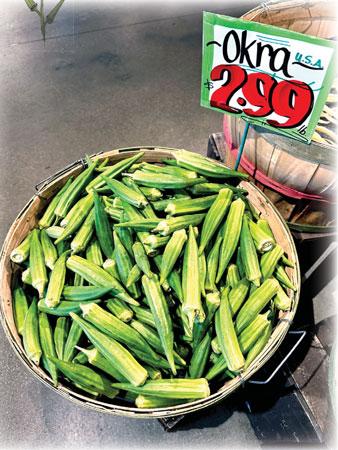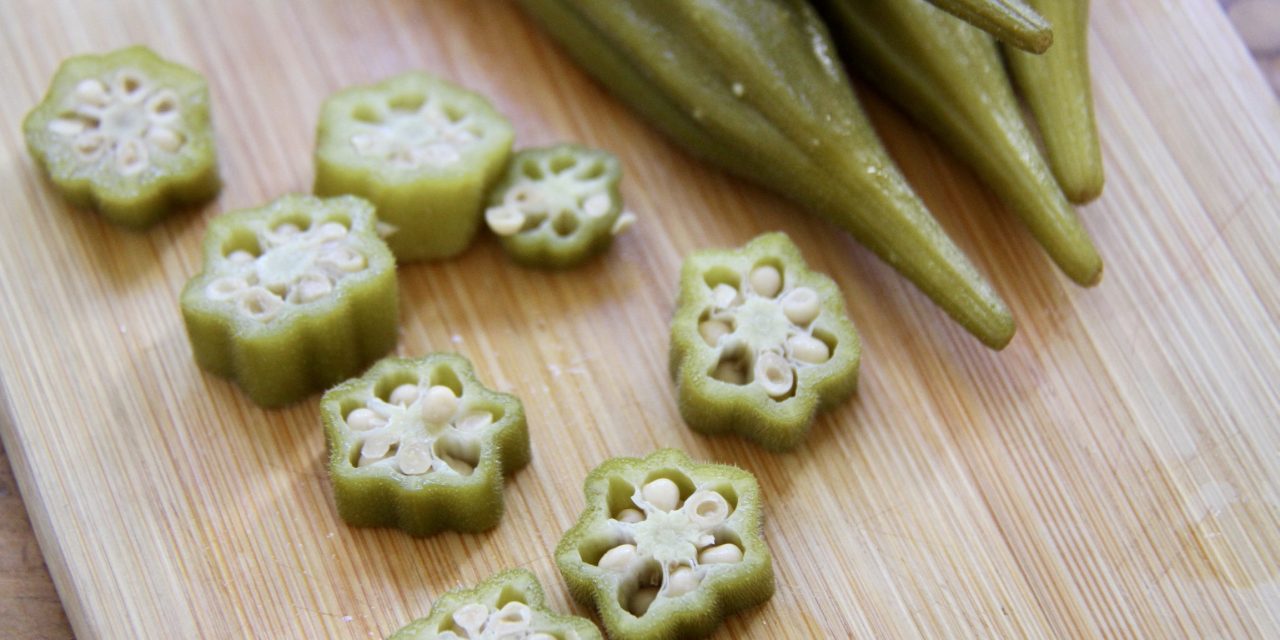
Okra is one of those vegetables that you either love, hate, or have never tried. Despite my varied palate, okra hadn’t graced my own plate until a few years ago. Okra isn’t exactly considered a New England delicacy and is not often found on restaurant menus in this part of the country. It also can be tricky to locate in smaller grocery stores and markets, and I have yet to see it at local farms. This needs to change; it is a vegetable worth discovering!

Okra illustration by Michael Hart
Found in African, Southern, Indian, and Caribbean cuisines, among others, okra is an edible seed pod, an almost banana-pepper-looking pod loaded with tiny white seeds that offer a satisfying pop when eaten. Okra is often used in soups and stews, but whole pods can be fried, pickled, or grilled. Some people do not like okra, as depending on how it’s prepared, it can be somewhat slimy because of the mucilage, or sugar residue, present. This same mucilage is what thickens up stews and gumbos and can be appealing to others’ palates. It’s a divisive vegetable.
My introduction to okra began when I was looking for a hearty stew recipe, and instead found a roasted red pepper gumbo recipe. Being a huge fan of red peppers and curious about the yet-to-be-tried gumbo, I decided to give it a go and started jotting down the ingredients, but I stopped at okra. I asked my husband for an assist on the subject, and nada… he had never tried it either. I shrugged and added it to the list, unsure if I’d be able to locate or even identify it. Once at the store, I was pleased to find fresh okra, frozen cut okra, and frozen whole okra.
Prepping okra for gumbo was easy. After removing the stem, the vegetable is sliced into small rounds, giving you a first glimpse at the small round seeds. It’s similar to cutting up peppers. The slimy nature of okra doesn’t appear until after cooking.
All it took was one bowl of gumbo and we were both hooked. Gumbo quickly became a staple in my house. I was curious about what else I could toss okra in and found a recipe for jambalaya in which it was included. Depending on who you ask, okra may or may not belong in jambalaya. I think it does. Plus, okra is packed with antioxidants and vitamins, is high in fiber, can help reduce cholesterol and control blood sugar. If you’re inclined to label things as “superfoods,” this is one of them.

A visit to a grocery store in Michigan inspired Laurie, the eSEMA publisher, to suggest this topic to Kendra.
I encourage you to try okra and spread the word! I’d love to see it at local farms. If farmers are including items as weird as celeriac in their CSAs, why not okra? I recently talked to Andy Pollack and he told me he used to grow okra for Silverbrook Farm. This surprised me as I have never seen okra grown locally. He said it grew well in Dartmouth, so there are no excuses for not adopting a new crop around here! Next time you’re at a farm, inquire about them growing okra (assuming you are as enthusiastic as I am about it)!
In an attempt to spread the okra love, I’ve included a recipe for jambalaya. It’s very slightly adapted from the website Gimme Some Oven. I usually like to modify recipes and do my own thing, but this barely needed any adjustments—I think it’s perfect! It’s a crowd-pleaser with delicious flavor and makes for a great dinner or potluck dish. My preference is to make it with brown rice, but white rice is also delicious and shortens your cooking time tremendously. I tend to make jambalaya with shrimp and sausage, but some folks include chicken as well. I personally don’t eat meat, so I usually substitute a hot Italian vegetarian sausage for the andouille that is traditionally included in jambalaya. If using vegetarian sausage, stir it in at the very end just before serving, to prevent it from getting soggy.
Ask eSEMA: Okra FAQ’s
Q: What is Okra and how does it grow?
A: okra, (Abelmoschus esculentus), herbaceous hairy annual plant of the mallow family (Malvaceae) and its edible fruit. It is native to the tropics of the Eastern Hemisphere and is widely cultivated or naturalized in the tropics and subtropics of the Western Hemisphere. See this answer and more details on Britiannica.com.
Q: Can you eat Okra raw?
A: Yes, you can eat okra raw, but it’s important to note that raw okra can have a slightly slimy texture. This sliminess is more pronounced when okra is cooked, but it’s still present to some extent when eaten raw. Some people enjoy the crunch and flavor of raw okra, while others might find the texture less appealing.
Q: What are the health benefits of Okra?
A: okra is packed with antioxidants and vitamins, is high in fiber, and can help reduce cholesterol, and control blood sugar. If you’re inclined to label things as “superfoods,” this is one of them. More details here.

Jambalaya with Okra
Ingredients
- 3 tablespoons avocado oil divided
- 3 bell peppers diced (any color or a mix works here)
- 2 celery ribs diced
- 2 jalapeńo peppers diced (remove the seeds if you don’t like a lot of heat)
- 1 red onion diced
- 4 cloves garlic minced
- 14 ounce can crushed tomatoes
- 4 cups stock I use vegetable, but chicken is nice as well
- 1½ cups uncooked brown rice
- 2 tablespoons Cajun seasoning
- 1 teaspoon dried thyme
- 1 bay leaf
- 1 pound cooked andouille or hot Italian sausage sliced into rounds or half-moons
- 1 pound raw shrimp peeled and deveined
- 1 cup sliced okra frozen works fine if you cannot find fresh, just defrost first
Instructions
- Heat 1 tablespoon oil in a dutch oven over medium-high heat. Add the sausage and sauté for 5 minutes, until browned. Remove from pot and set aside.
- Add 2 tablespoons oil to the stock pot. Add bell peppers, celery, jalapeno, onion, and garlic. Sauté for 6 minutes, stirring occasionally, until the onions are softened.
- Add the crushed tomatoes, chicken stock, rice, Cajun seasoning, thyme, cayenne, and bay leaf, and stir to combine. Continue cooking until the mixture reaches a simmer. Then reduce heat to medium-low, cover to simmer for about 45 to 65 minutes, or until the rice is nearly cooked through, stirring every 5 minutes or so along the way so that the rice does not burn. Add more stock or water if necessary.
- While jambalaya is cooking, heat remaining oil in a small pan. Add sausage, and cook for about 5 minutes, until browned.
- When rice is almost done cooking add the shrimp, okra, and sausage and stir to combine. Continue to simmer, stirring occasionally, until the shrimp are cooked through and pink. Discard bay leaf.
- Season with salt and pepper. You will likely need 1 or 2 teaspoons of salt depending on how salty your stock was.
- Enjoy!







